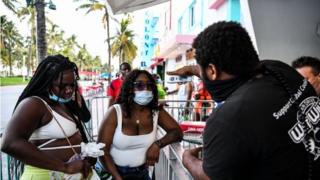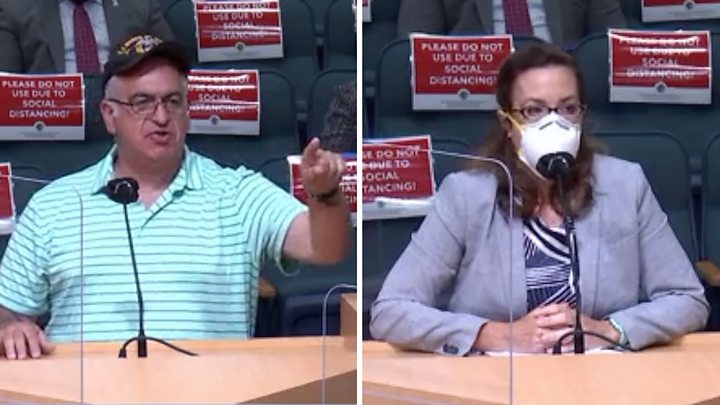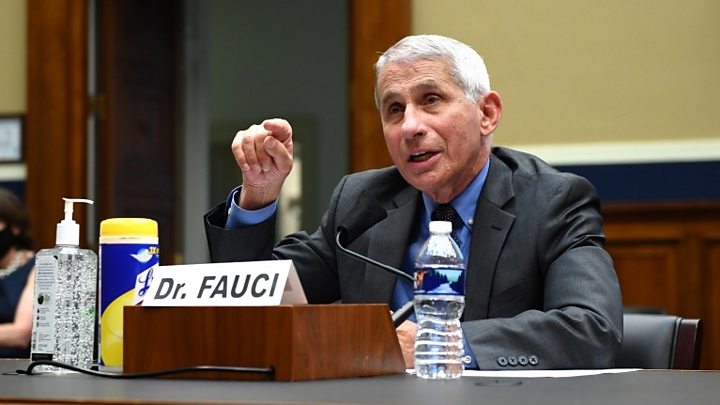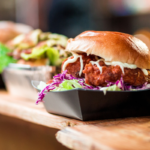
 Image copyright
Image copyright
AFP
States like Florida are experiencing rates of infection not seen since April
The United States recorded an all-time daily high of 40,000 coronavirus infections on Thursday, figures from Johns Hopkins University (JHU) show.
A recent surge in infections and hospitalisations has prompted the states of Texas, Florida and Arizona to pause reopening plans.
Texas’s governor ordered bars to close and announced other “targeted measures” on Friday to bring infections down.
Florida announced it was suspending alcohol consumption at its bars.
JHU’s previous high of 36,400 was on 24 April when less testing took place.
The US has 2.4 million confirmed infections and 122,370 deaths – more than any other country.
While some of the increase in daily cases recorded is down to increased testing, the rate of positive tests in some areas is also increasing.

Media playback is unsupported on your device
Health officials in the US estimate the true number of cases is likely to be 10 times higher than the reported figure.
The Centers for Disease Control (CDC) said up to 20 million Americans may have been infected with coronavirus. The estimate was based on blood samples collected from across the country which were tested for the presence of antibodies to the virus.
The surge in cases was being driven by young people testing positive, especially in the south and west of the US, said the head of the CDC, Dr Robert Redfield.
The Trump administration has stressed that the situation is stabilising in most of the country.
Which states are worst hit?
Texas, which has been at the forefront of moves to end lockdown measures, has seen thousands of new cases, prompting Republican Governor Greg Abbott to call a temporary halt to its reopening on Friday.
He announced that he was closing bars, stopping river-rafting, and ordering restaurants to return to 50% capacity to try to stem the outbreak.
Image copyright
AFP
Bars like this one in Houston have to close but could run deliveries or takeaway services
“It is clear that the rise in cases is largely driven by certain types of activities, including Texans congregating in bars,” he said in a statement.
Texas confirmed a record 5,996 new cases on Thursday, while there were also 47 more deaths reported, the highest daily toll for a month.
In his first coronavirus briefing in more than two months, Vice-President Mike Pence said the White House supported the measures taken by Texas, and called on people in the affected states to follow the official advice.
On Friday, Florida broke its own daily record for new infections, reporting 8,942 new cases. The previous record was 5,508, reported on Wednesday. The state now has a total of 122,960 recorded cases and 3,366 deaths.
State officials announced that alcohol consumption was being suspended at bars across the state. However, it was not clear how the new measures would affect restaurants that served alcohol, the Miami Herald reported.
Earlier, Florida’s governor said there was no plan to continue reopening step-by-step. “We are where we are. I didn’t say we were going to go on to the next phase,” Ron DeSantis told reporters.
Arizona has emerged as another epicentre of the crisis. Disease trackers there say the state has “lost control of the epidemic”, the Washington Post reports. Governor Doug Ducey, who had been giving businesses a “green light” to reopen, now says Arizona residents are “safer at home”.
The light is at “yellow”, Gov Ducey said on Thursday. “I’m asking for Arizonans to proceed with caution, to go slower, to look both ways.”
Other states, including Alabama, California, Idaho, Mississippi, Missouri, Nevada, Oklahoma, South Carolina and Wyoming, have all seen record daily increases in the number of confirmed cases this week.

Media playback is unsupported on your device
New York, New Jersey and Connecticut have said they will ask people travelling from eight states – Alabama, Arkansas, Arizona, Florida, North Carolina, South Carolina, Texas and Utah – to go into self-isolation for 14 days.
In California, which reported a record 7,149 new confirmed cases on Wednesday, Disney said it was delaying reopening of its Disneyland Park and Disney California Adventure Park originally set for 17 July. The company said it first needed to receive approval from government officials.
Governor Gavin Newsom said the state had carried out more than a million tests over the past two weeks, with about 5% coming back positive. Mr Newsom has made wearing a face mask mandatory in public.
The University of Washington predicts 180,000 US deaths by October – or 146,000 if 95% of Americans wear masks.
The European Union is reportedly considering banning US citizens from entering the bloc as it considers how to reopen its external borders.
How has the US responded to the pandemic?
The US federal system of government allows states freedom to devise their own solutions and policies to pressing concerns – even a national health crisis.
Governors have therefore been responsible for the varying degrees of lockdown put in place to curtail the spread of Covid-19.
That patchwork response has also been marked by contention between the Trump administration and some governors.
Back in March, President Trump made it clear he wanted to see America reopen for business “soon”.
Faced with rising unemployment and an economic crisis just months ahead of November’s election, he tweeted at the time: “We cannot let the cure be worse than the problem itself.”
The president even went so far as to endorse street protests against stringent lockdown measures in several states.
Then, in April, President Trump unveiled guidance to governors on reopening state economies.
The guidelines for “Opening up America Again” outlined three phases for states to gradually ease their lockdowns.
Mr Trump promised governors they would be handling the process themselves, with help from the federal government.


